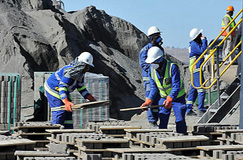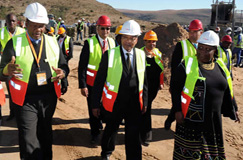Development
Mandela bridge to boost E Cape tourism
Addressing government priority areas
"There will be interest among tourists to learn about Nelson Mandela's birthplace," Nkwinti said. "The bridge will also attract more schools to visit the area as more schools are keen to learn about Madiba's birthplace." Mvezo Museum is already operational, but it is not easily accessible. Nkwinti said once the bridge was completed, tourists would have access to the museum, which displays Mandela's legacy. Schools would also have a chance to initiate activities such as cultural dances, arts and crafts, which could be sold to tourists. "Stimulation of tourism in the area is likely to result in the creation of businesses in the tourism sector locally and in the province as a whole," Nkwinti said. "There will be restoration of self-esteem to both Mvezo and Ludondolo residents as they will no longer be subjected to an embarrassing and inconveniencing situation of removing their clothes whenever they need to cross the Mbashe River in their attempt to access basic services such as schools and clinics." Government priority areas such as job creation, access to education, health services and local economic development would also be addressed through construction of the bridge, he said. Transport would be positively affected too, as the taxi industry agreed to extend their services to the villages of Ludondolo and Mvezo once the tarred road and bridge were complete. President Zuma said the distance to Qunu village, where Madiba now lives, would be radically shortened thanks to the bridge. "Many visitors, both from our country and abroad, who wish to visit the birthplace of this world icon, will be able to do so by branching off from the national road and travelling a relatively short distance on a new road, thus turning Mvezo potentially into a major tourist attraction," Zuma said. There are also plans for the construction of the Nelson Mandela Science and Technology High School in Mvezo.'Creating a more employable workforce'
The construction of the bridge has resulted in the improvement of job creation and skills development in the area as workers have been trained in steel fixing, bricklaying, paving and carpentry - skills that Zuma said would make them employable in future. "I have no doubt that the skills acquired during the bridge and road building process will enable these workers to become more employable in the future, and to access jobs elsewhere even after the completion of the project, and these workers will themselves have easier access to nearby towns," said Zuma. The Rural Development and Land Reform Department has purchased a brick-making machine which is being used to manufacture bricks during the construction of the bridge. Once the bridge and road construction projects are completed, the department will hand over the brick-making machine to the trained workers to set up a brick-making enterprise. Source: SANews.gov.za
Workers making bricks for the construction of the Nelson Mandela Legacy Bridge in Mvezo in the Eastern Cape province (Photo: GCIS)

Rural Development and Land Reform Minister Gugile Nkwinti, President Jacob Zuma and Eastern Cape Premier Noxolo Kiviet inspect the progress of construction on the Mandela bridge in Mvezo, Eastern Cape province (Photo: GCIS)
Related links
Related articles
- Mandela bridge project under way
- SA infrastructure plan 'ready to roll'
- Empowering the rural woman
- SA eyes up to 100 000 construction jobs
- Infrastructure master plan 'on track'
- Infrastructure: getting the spending right
- Huge infrastructure opportunities: Zuma
- SA set for massive infrastructure drive
- Housing gives hope to rural communities
- Mvezo school a legacy of Mandela
- Energy centres for rural development
- Consumer centres for rural towns



